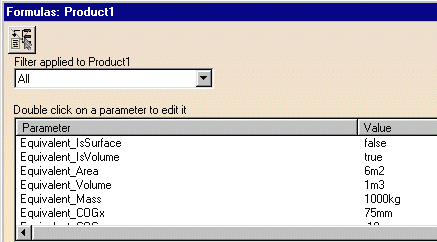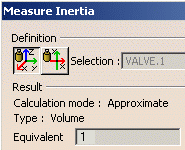This section deals with the following procedures:
Understanding Inertia Equivalents
Inertia Equivalents
Equivalents are user parameters set using the Knowledgeware
formula command
![]() under parts or products and imported from text (*txt) or Excel (*xls)
files.
under parts or products and imported from text (*txt) or Excel (*xls)
files.
If your document contains inertia equivalents set using Knowledgeware capabilities, then the Inertia command will not calculate the inertia properties of the selected geometry but return the equivalent values.
The Equivalent box of the Measure Inertia dialog
box indicates whether or not equivalents have been used:
-
0: the measure is made on the selection, geometry or assembly
-
1 or more: One or more inertia equivalents are taken into account.
|
|
Displaying Inertia Equivalents in the Measure
Inertia dialog box
-
Click Customize... in the Measure Inertia dialog box.
The Measure Inertia Customization dialog box appears. -
Select Equivalent checkbox in the Measure Inertia Customization dialog box.
-
Click Apply.
Sets of equivalent parameters must be valid to be taken into account. To be valid, all the properties shown in the example below must be listed.
An example of a text file follows. In text files, the name of the property and the value are separated by a tab stop.
Equivalent_IsSurface false
Equivalent_IsVolume true
Equivalent_Area 6m2
Equivalent_Volume 1m3
Equivalent_Mass 1000kg
Equivalent_COGx 75mm
Equivalent_COGy -10mm
Equivalent_COGz -25mm
Equivalent_MatGxx 50000gxmm2
Equivalent_MatGyy 50000gxmm2
Equivalent_MatGzz 50000gxmm2
Equivalent_MatGxy 0gxmm2
Equivalent_MatGxz 0gxmm2
Equivalent_MatGyz 0gxmm2In Excel files, simply list property names and values in two separate columns.
Importing Inertia Equivalents
-
Select the product to which you want to associate inertia equivalents.
-
Click formula
 .
. -
Click Import... in the Formulas dialog box.
-
Select the text or Excel file containing the inertia equivalents in the file selection dialog box, then click Open.
Parameters to be imported are listed

-
Click OK to import all the parameters listed into the document.
Imported parameters are now displayed in the Formulas dialog box

-
Click OK in the Formulas dialog box. You are now ready to run your inertia calculation.

-
Having imported inertia equivalents, you no longer need the representations of the product or sub-products and you can de-activate them (Edit > Representations). De-activated representations are unloaded. This frees the geometry area and improves system response time.
-
To display parameters in the specification tree, select the Parameters checkbox Display in Specification Tree in the Display tab of the Options dialog box (Tools > Options > Infrastructure > Part Infrastructure).
-
![]()
